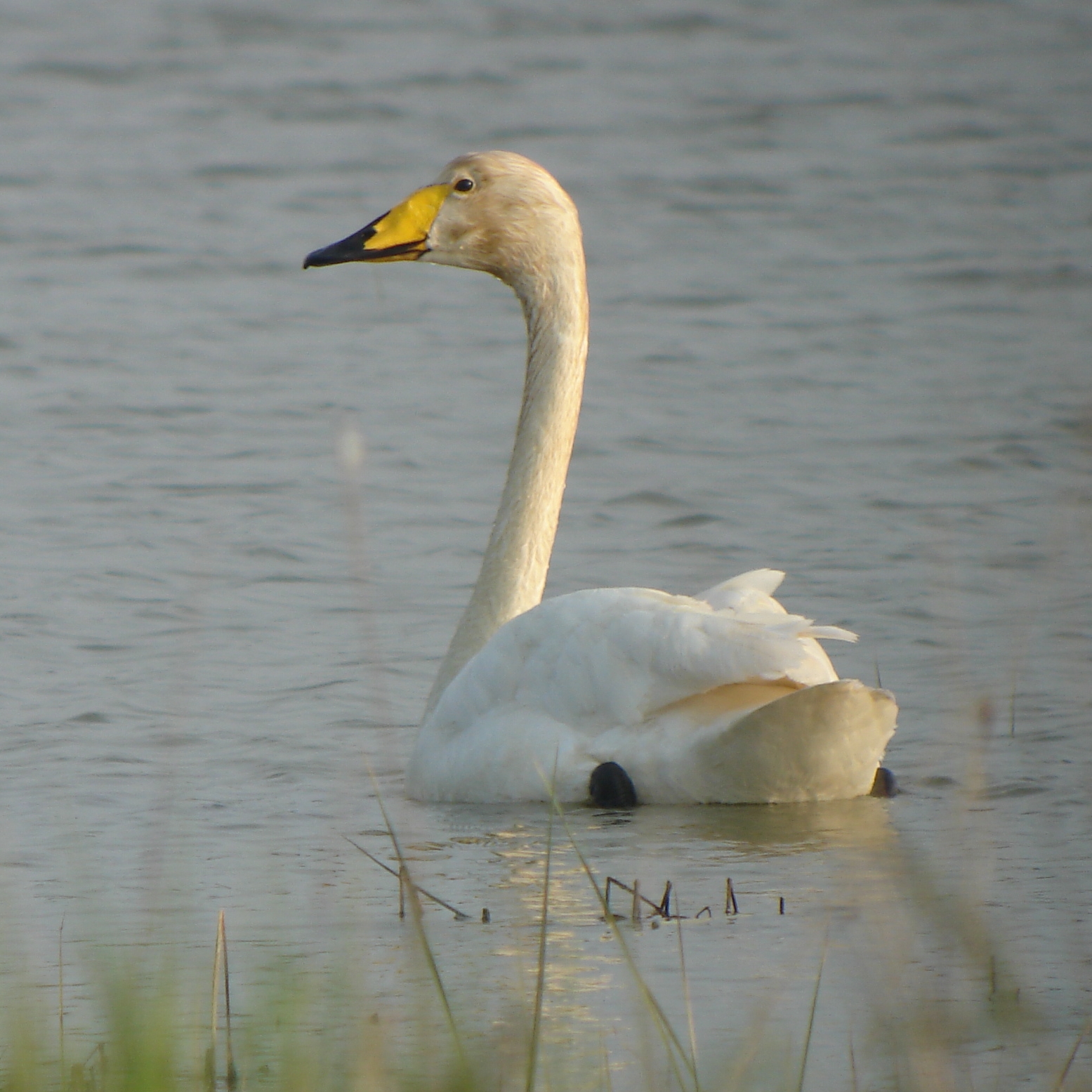- Anseriformes
Taxobox
name = Anseriformes
image_width = 220px
image_caption =Whooper Swan ("Cygnus cygnus"), a member of theAnatidae
regnum =Animal ia
phylum =Chordata
classis =Aves
subclassis =Neornithes
infraclassis =Galloanserae
ordo = Anseriformes
ordo_authority = Wagler, 1831
subdivision_ranks = Families
subdivision =Anhimidae Anseranatidae Anatidae
Forfossil families, see textThe order Anseriformes contains about 150 living
species ofbird s in three extant families: theAnhimidae (the screamers),Anseranatidae (theMagpie-goose ), and theAnatidae , which includes over 140 species ofwaterfowl , among them theduck s, geese, andswan s.All species in the order are highly adapted for an aquatic existence at the water surface. All are web-footed for efficient swimming (although some have subsequently become mainly terrestrial).
Evolution
The earliest known Anseriform is the recently discovered "
Vegavis ", which lived during theCretaceous period [Clarke "et al." (2005)] . It is thought that the Anseriformes originated when the originalGalloanserae (the group to which Anseriformes andGalliformes belong) split into the two main lineages. The extinctdromornithids represent early offshoots of the anseriform line, possibly derived fromscreamer -like ancestors, and so maybeGastornis (if it is an Anseriform). The ancestors of the Anseriformes developed the characteristic bill structure that they still share. The combination of the internal shape of the bill and a modified tongue acts as a suction pump to draw water in at the tip of the bill and expel it from the sides and rear; an array of fine filter plates called "lamellae" traps small particles, which are then licked off and swallowed.All Anseriformes have this basic structure, but many have subsequently adopted alternative feeding strategies: geese graze on plants, the saw-billed ducks catch fish; even the
screamer s, which have bills that seem on first sight more like those of the game birds, still have vestigal lamellae. The prehistoric wadingpresbyornithids and the huge and possiblycarnivorous dromornithids were even more bizarre.ystematics
The Anseriformes and the
Galliformes (pheasants etc) are the most primitive neognathous birds, and should followratite s andtinamou s in bird classification systems.Anatidae systematics, especially regarding placement of some "odd" genera in the dabbling ducks or shelducks, is not fully resolved. See the Anatidae article for more information, and for alternate taxonomic approaches.ORDER ANSERIFORMES
* FamilyAnhimidae : screamers
* FamilyAnseranatidae : the Magpie-goose
* FamilyAnatidae
** SubfamilyDendrocygninae : Whistling ducks (sometimes given full family status as the Dendrocygnidae).
** SubfamilyThalassorninae : the White-backed Duck.
** SubfamilyAnserinae : Swans and geese.
** SubfamilyStictonettinae : the Freckled Duck.
** SubfamilyPlectropterinae : the Spur-winged Goose.
** SubfamilyTadorninae : Shelducks and sheldgeese - probablyparaphyletic
** SubfamilyAnatinae : Dabbling ducks and moa-nalos
** SubfamilyAythyinae : Diving ducks (sometimes included in Anatinae)
** SubfamilyMerginae : eiders, scoters, mergansers and other sea-ducks.
** SubfamilyOxyurinae : Stiff-tailed ducks and allies.
* FamilyDromornithidae (fossil ): mihirungs
* FamilyPresbyornithidae (fossil ): several genera of wading-"geese"The fossil
Gastornithidae (diatrymas) are also occasionally included herein as a family.Some fossil anseriform taxa not assignable with certainty to a family are:
* "Anatalavis " (Late Cretaceous/Early Paleocene - Early Eocene) - Anseranatidae or basal. Includes "Telmatornis" rex".
* "Proherodius " (London Clay Early Eocene of London, England) - Presbyornithidae?
* "Romainvillia " (Late Eocene/Early Oligocene) - Anseranatidae or Anatidae
* "Paranyroca " (Rosebud Early Miocene of Bennett County, USA) - Anatidae or own family?In addition, a considerable number of mainly Late Cretaceous and
Paleogene fossils have been described where it is uncertain whether or not they are anseriforms. This is because almost all orders of aquatic birds living today either originated or underwent a major radiation during that time, making it hard to decide whether some waterbird-like bone belongs into this family or is the product of parallel evolution in a different lineage due to adaptive pressures.* "
Apatornis " (Smoky Hill Chalk Late Cretaceous of Twin Butte Creek, USA)
* "Vegavis " (Late Cretaceous) - closer to Presbyornithidae and Anatidae than to Anseranatidae
* "Presbyornithidae" gen. et sp. indet. (Barun Goyot Late Cretaceous of Udan Sayr, Mongolia) - Presbyornithidae?
* UCMP 117599 (Hell Creek Late Cretaceous of Bug Creek West, USA)
* "Petropluvialis " (Late Eocene of England) - may be same as "Palaeopapia"
* "Agnopterus " (Late Eocene - Late Oligocene of Europe) - includes "Cygnopterus lambrechti"
* "Headonornis hantoniensis" BMNH PAL 4989 (Hampstead Early Oligocene of Isle of Wight, England) - formerly "Ptenornis"
* "Palaeopapia " (Hampstead Early Oligocene of Isle of Wight, England)
* "Anas" creccoides" (Early/Middle Oligocene of Belgium)
* "Anas" skalicensis" (Early Miocene of "Skalitz", Czechia)
* "Anas" risgoviensis" (Late Miocene of Bavaria, Germany)Footnotes
References
* (2005): Definitive fossil evidence for the extant avian radiation in the Cretaceous. "Nature" 433: 305-308. doi|10.1038/nature03150 [http://www.digimorph.org/specimens/Vegavis_iaai/nature03150.pdf PDF fulltext] [http://www.nature.com/nature/journal/v433/n7023/suppinfo/nature03150.html Supporting information]
Wikimedia Foundation. 2010.
